Management Accounting Techniques and Financial Issues
VerifiedAdded on 2023/01/09
|7
|1616
|53
AI Summary
This report discusses the use of management accounting techniques in dealing with financial issues. It covers topics such as incremental column analysis, elimination of divisions, and financial problems faced by organizations. The report also explores techniques like benchmarking, key performance indicators, and financial governance to identify and resolve these issues. The subject of the report is management accounting and the course code is not mentioned. The document type is a report or assignment.
Contribute Materials
Your contribution can guide someone’s learning journey. Share your
documents today.
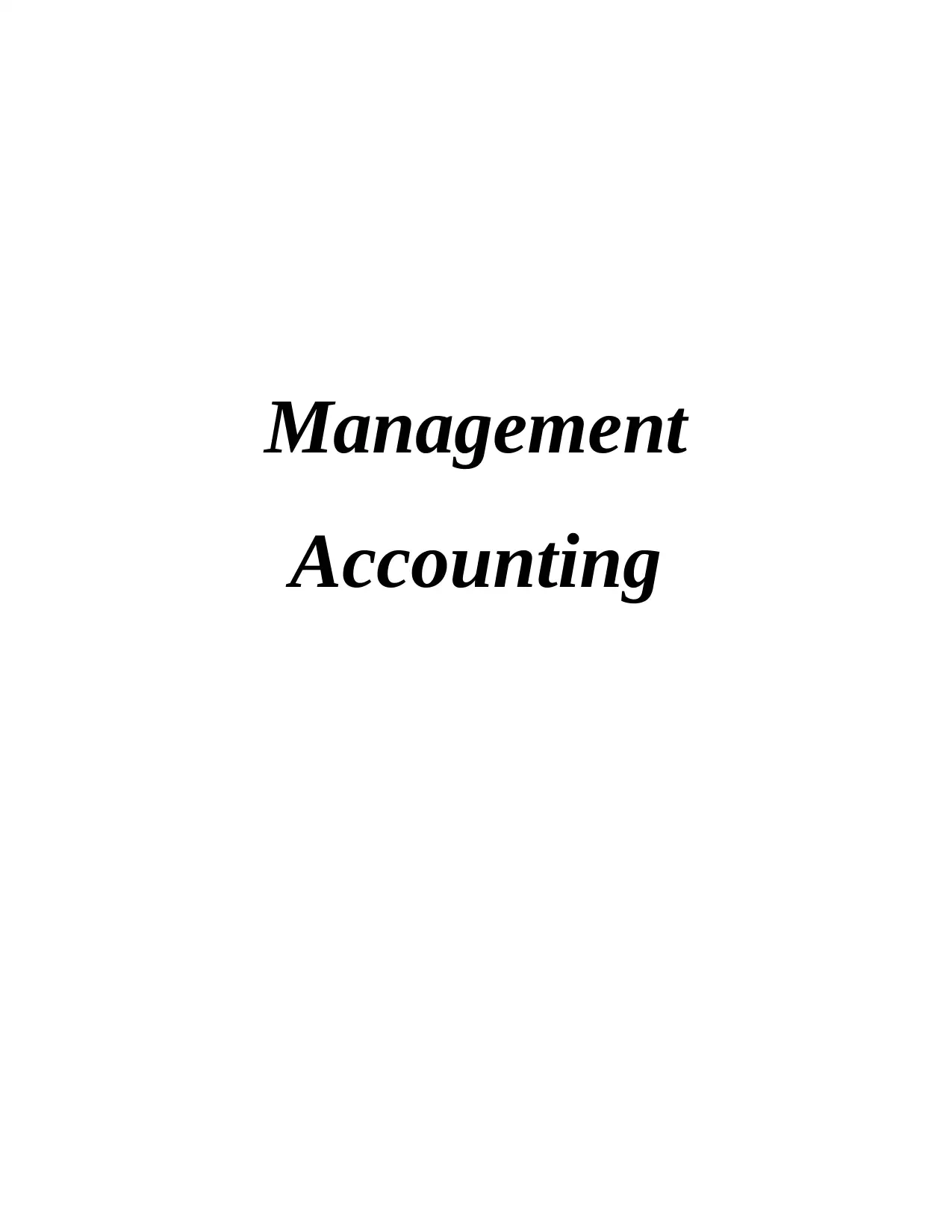
Management
Accounting
Accounting
Secure Best Marks with AI Grader
Need help grading? Try our AI Grader for instant feedback on your assignments.
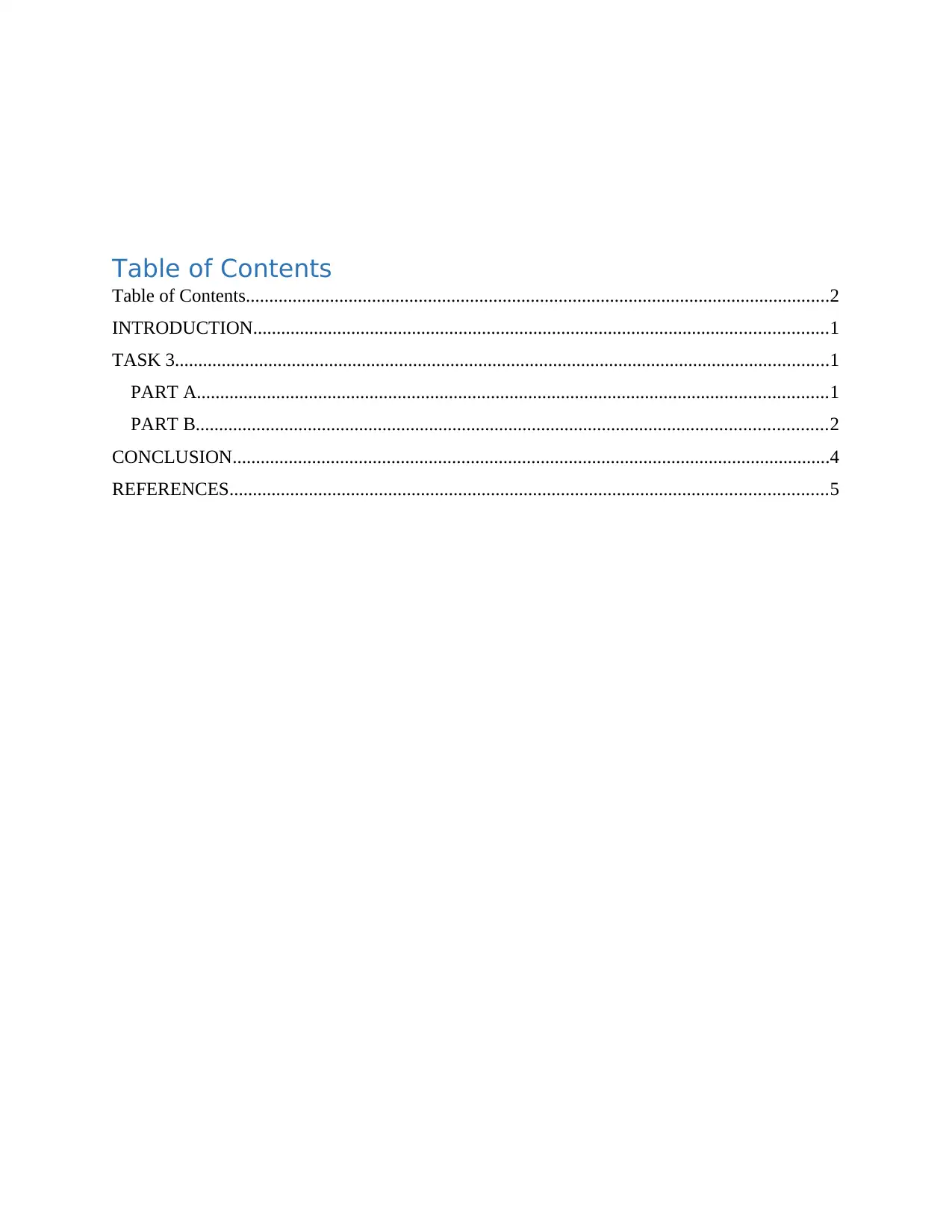
Table of Contents
Table of Contents.............................................................................................................................2
INTRODUCTION...........................................................................................................................1
TASK 3............................................................................................................................................1
PART A.......................................................................................................................................1
PART B.......................................................................................................................................2
CONCLUSION................................................................................................................................4
REFERENCES................................................................................................................................5
Table of Contents.............................................................................................................................2
INTRODUCTION...........................................................................................................................1
TASK 3............................................................................................................................................1
PART A.......................................................................................................................................1
PART B.......................................................................................................................................2
CONCLUSION................................................................................................................................4
REFERENCES................................................................................................................................5
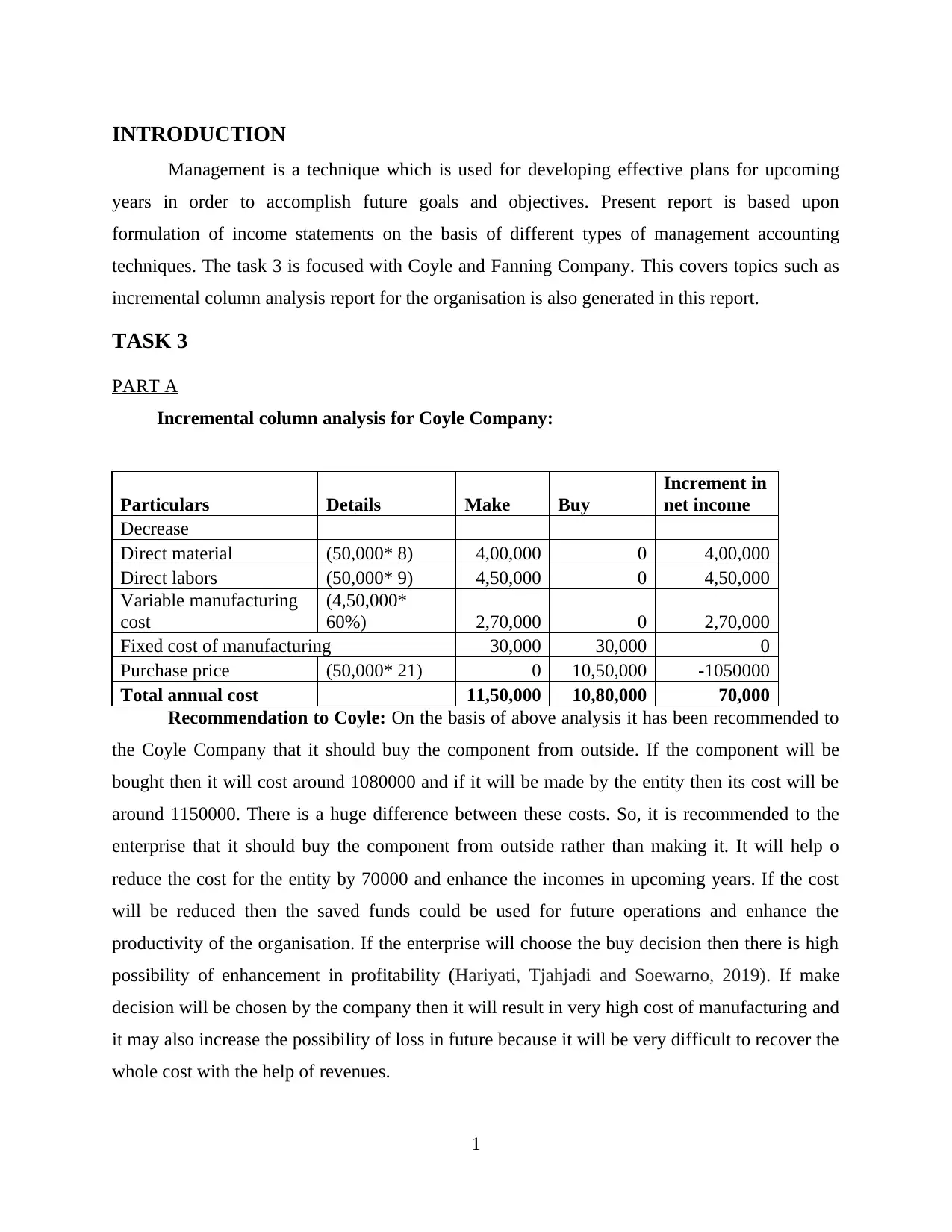
INTRODUCTION
Management is a technique which is used for developing effective plans for upcoming
years in order to accomplish future goals and objectives. Present report is based upon
formulation of income statements on the basis of different types of management accounting
techniques. The task 3 is focused with Coyle and Fanning Company. This covers topics such as
incremental column analysis report for the organisation is also generated in this report.
TASK 3
PART A
Incremental column analysis for Coyle Company:
Particulars Details Make Buy
Increment in
net income
Decrease
Direct material (50,000* 8) 4,00,000 0 4,00,000
Direct labors (50,000* 9) 4,50,000 0 4,50,000
Variable manufacturing
cost
(4,50,000*
60%) 2,70,000 0 2,70,000
Fixed cost of manufacturing 30,000 30,000 0
Purchase price (50,000* 21) 0 10,50,000 -1050000
Total annual cost 11,50,000 10,80,000 70,000
Recommendation to Coyle: On the basis of above analysis it has been recommended to
the Coyle Company that it should buy the component from outside. If the component will be
bought then it will cost around 1080000 and if it will be made by the entity then its cost will be
around 1150000. There is a huge difference between these costs. So, it is recommended to the
enterprise that it should buy the component from outside rather than making it. It will help o
reduce the cost for the entity by 70000 and enhance the incomes in upcoming years. If the cost
will be reduced then the saved funds could be used for future operations and enhance the
productivity of the organisation. If the enterprise will choose the buy decision then there is high
possibility of enhancement in profitability (Hariyati, Tjahjadi and Soewarno, 2019). If make
decision will be chosen by the company then it will result in very high cost of manufacturing and
it may also increase the possibility of loss in future because it will be very difficult to recover the
whole cost with the help of revenues.
1
Management is a technique which is used for developing effective plans for upcoming
years in order to accomplish future goals and objectives. Present report is based upon
formulation of income statements on the basis of different types of management accounting
techniques. The task 3 is focused with Coyle and Fanning Company. This covers topics such as
incremental column analysis report for the organisation is also generated in this report.
TASK 3
PART A
Incremental column analysis for Coyle Company:
Particulars Details Make Buy
Increment in
net income
Decrease
Direct material (50,000* 8) 4,00,000 0 4,00,000
Direct labors (50,000* 9) 4,50,000 0 4,50,000
Variable manufacturing
cost
(4,50,000*
60%) 2,70,000 0 2,70,000
Fixed cost of manufacturing 30,000 30,000 0
Purchase price (50,000* 21) 0 10,50,000 -1050000
Total annual cost 11,50,000 10,80,000 70,000
Recommendation to Coyle: On the basis of above analysis it has been recommended to
the Coyle Company that it should buy the component from outside. If the component will be
bought then it will cost around 1080000 and if it will be made by the entity then its cost will be
around 1150000. There is a huge difference between these costs. So, it is recommended to the
enterprise that it should buy the component from outside rather than making it. It will help o
reduce the cost for the entity by 70000 and enhance the incomes in upcoming years. If the cost
will be reduced then the saved funds could be used for future operations and enhance the
productivity of the organisation. If the enterprise will choose the buy decision then there is high
possibility of enhancement in profitability (Hariyati, Tjahjadi and Soewarno, 2019). If make
decision will be chosen by the company then it will result in very high cost of manufacturing and
it may also increase the possibility of loss in future because it will be very difficult to recover the
whole cost with the help of revenues.
1
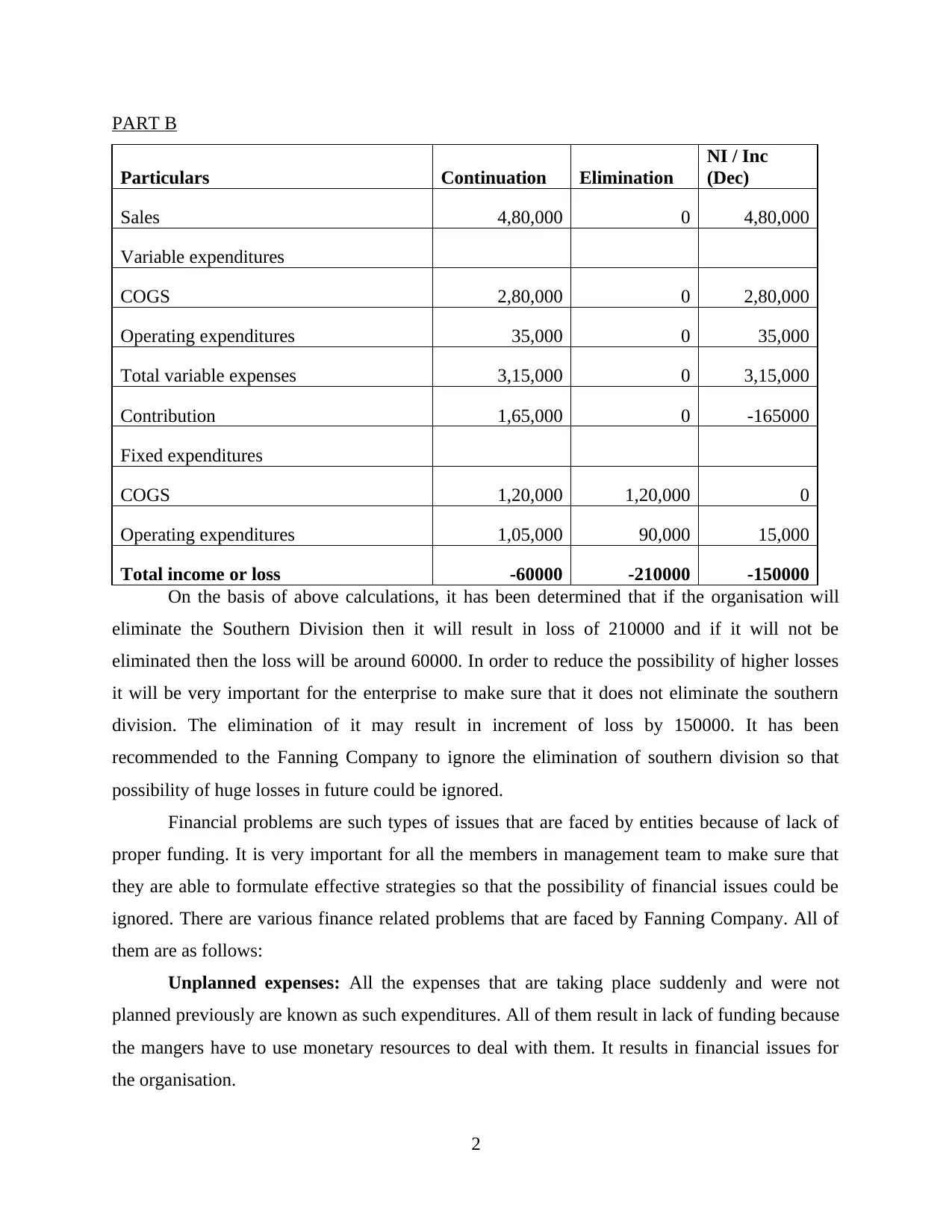
PART B
Particulars Continuation Elimination
NI / Inc
(Dec)
Sales 4,80,000 0 4,80,000
Variable expenditures
COGS 2,80,000 0 2,80,000
Operating expenditures 35,000 0 35,000
Total variable expenses 3,15,000 0 3,15,000
Contribution 1,65,000 0 -165000
Fixed expenditures
COGS 1,20,000 1,20,000 0
Operating expenditures 1,05,000 90,000 15,000
Total income or loss -60000 -210000 -150000
On the basis of above calculations, it has been determined that if the organisation will
eliminate the Southern Division then it will result in loss of 210000 and if it will not be
eliminated then the loss will be around 60000. In order to reduce the possibility of higher losses
it will be very important for the enterprise to make sure that it does not eliminate the southern
division. The elimination of it may result in increment of loss by 150000. It has been
recommended to the Fanning Company to ignore the elimination of southern division so that
possibility of huge losses in future could be ignored.
Financial problems are such types of issues that are faced by entities because of lack of
proper funding. It is very important for all the members in management team to make sure that
they are able to formulate effective strategies so that the possibility of financial issues could be
ignored. There are various finance related problems that are faced by Fanning Company. All of
them are as follows:
Unplanned expenses: All the expenses that are taking place suddenly and were not
planned previously are known as such expenditures. All of them result in lack of funding because
the mangers have to use monetary resources to deal with them. It results in financial issues for
the organisation.
2
Particulars Continuation Elimination
NI / Inc
(Dec)
Sales 4,80,000 0 4,80,000
Variable expenditures
COGS 2,80,000 0 2,80,000
Operating expenditures 35,000 0 35,000
Total variable expenses 3,15,000 0 3,15,000
Contribution 1,65,000 0 -165000
Fixed expenditures
COGS 1,20,000 1,20,000 0
Operating expenditures 1,05,000 90,000 15,000
Total income or loss -60000 -210000 -150000
On the basis of above calculations, it has been determined that if the organisation will
eliminate the Southern Division then it will result in loss of 210000 and if it will not be
eliminated then the loss will be around 60000. In order to reduce the possibility of higher losses
it will be very important for the enterprise to make sure that it does not eliminate the southern
division. The elimination of it may result in increment of loss by 150000. It has been
recommended to the Fanning Company to ignore the elimination of southern division so that
possibility of huge losses in future could be ignored.
Financial problems are such types of issues that are faced by entities because of lack of
proper funding. It is very important for all the members in management team to make sure that
they are able to formulate effective strategies so that the possibility of financial issues could be
ignored. There are various finance related problems that are faced by Fanning Company. All of
them are as follows:
Unplanned expenses: All the expenses that are taking place suddenly and were not
planned previously are known as such expenditures. All of them result in lack of funding because
the mangers have to use monetary resources to deal with them. It results in financial issues for
the organisation.
2
Secure Best Marks with AI Grader
Need help grading? Try our AI Grader for instant feedback on your assignments.
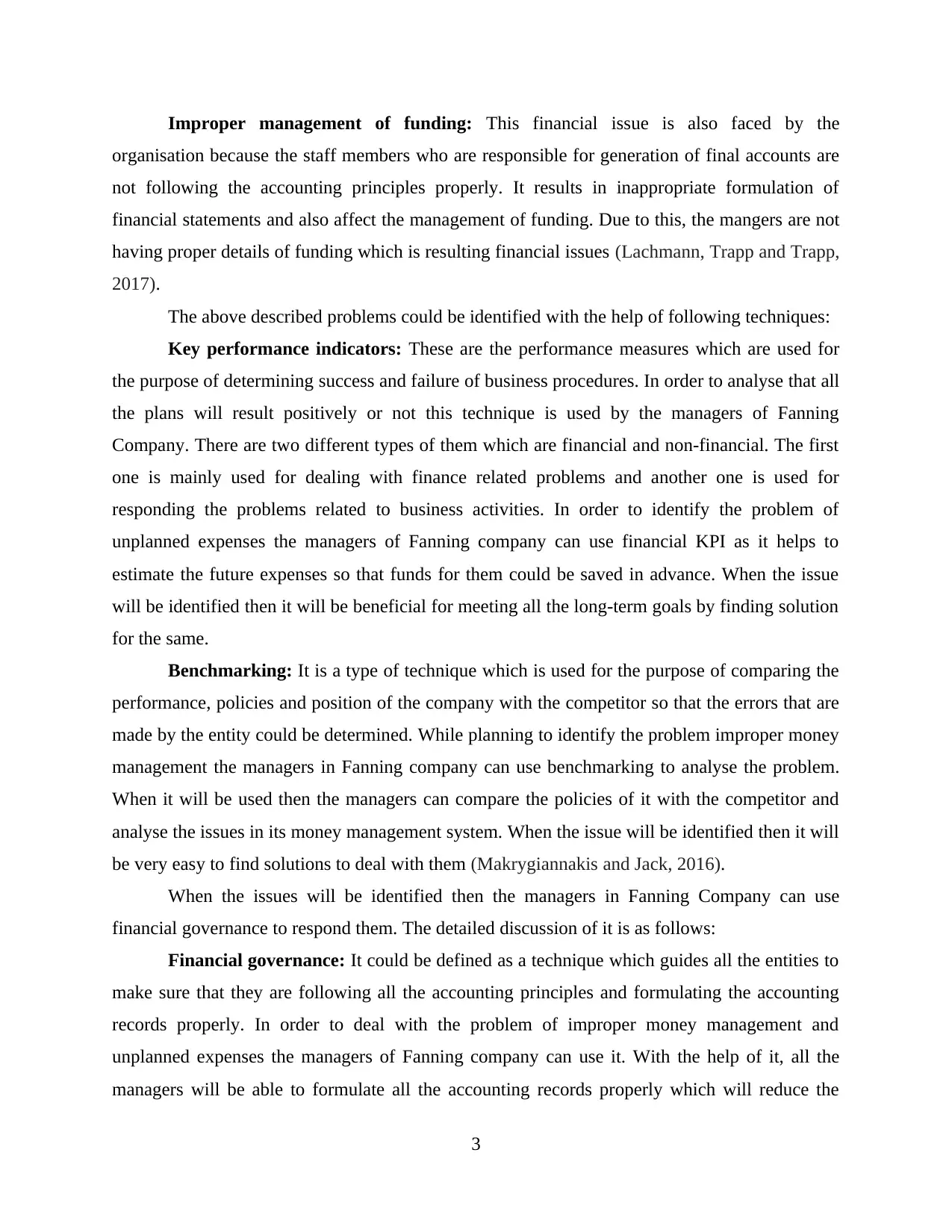
Improper management of funding: This financial issue is also faced by the
organisation because the staff members who are responsible for generation of final accounts are
not following the accounting principles properly. It results in inappropriate formulation of
financial statements and also affect the management of funding. Due to this, the mangers are not
having proper details of funding which is resulting financial issues (Lachmann, Trapp and Trapp,
2017).
The above described problems could be identified with the help of following techniques:
Key performance indicators: These are the performance measures which are used for
the purpose of determining success and failure of business procedures. In order to analyse that all
the plans will result positively or not this technique is used by the managers of Fanning
Company. There are two different types of them which are financial and non-financial. The first
one is mainly used for dealing with finance related problems and another one is used for
responding the problems related to business activities. In order to identify the problem of
unplanned expenses the managers of Fanning company can use financial KPI as it helps to
estimate the future expenses so that funds for them could be saved in advance. When the issue
will be identified then it will be beneficial for meeting all the long-term goals by finding solution
for the same.
Benchmarking: It is a type of technique which is used for the purpose of comparing the
performance, policies and position of the company with the competitor so that the errors that are
made by the entity could be determined. While planning to identify the problem improper money
management the managers in Fanning company can use benchmarking to analyse the problem.
When it will be used then the managers can compare the policies of it with the competitor and
analyse the issues in its money management system. When the issue will be identified then it will
be very easy to find solutions to deal with them (Makrygiannakis and Jack, 2016).
When the issues will be identified then the managers in Fanning Company can use
financial governance to respond them. The detailed discussion of it is as follows:
Financial governance: It could be defined as a technique which guides all the entities to
make sure that they are following all the accounting principles and formulating the accounting
records properly. In order to deal with the problem of improper money management and
unplanned expenses the managers of Fanning company can use it. With the help of it, all the
managers will be able to formulate all the accounting records properly which will reduce the
3
organisation because the staff members who are responsible for generation of final accounts are
not following the accounting principles properly. It results in inappropriate formulation of
financial statements and also affect the management of funding. Due to this, the mangers are not
having proper details of funding which is resulting financial issues (Lachmann, Trapp and Trapp,
2017).
The above described problems could be identified with the help of following techniques:
Key performance indicators: These are the performance measures which are used for
the purpose of determining success and failure of business procedures. In order to analyse that all
the plans will result positively or not this technique is used by the managers of Fanning
Company. There are two different types of them which are financial and non-financial. The first
one is mainly used for dealing with finance related problems and another one is used for
responding the problems related to business activities. In order to identify the problem of
unplanned expenses the managers of Fanning company can use financial KPI as it helps to
estimate the future expenses so that funds for them could be saved in advance. When the issue
will be identified then it will be beneficial for meeting all the long-term goals by finding solution
for the same.
Benchmarking: It is a type of technique which is used for the purpose of comparing the
performance, policies and position of the company with the competitor so that the errors that are
made by the entity could be determined. While planning to identify the problem improper money
management the managers in Fanning company can use benchmarking to analyse the problem.
When it will be used then the managers can compare the policies of it with the competitor and
analyse the issues in its money management system. When the issue will be identified then it will
be very easy to find solutions to deal with them (Makrygiannakis and Jack, 2016).
When the issues will be identified then the managers in Fanning Company can use
financial governance to respond them. The detailed discussion of it is as follows:
Financial governance: It could be defined as a technique which guides all the entities to
make sure that they are following all the accounting principles and formulating the accounting
records properly. In order to deal with the problem of improper money management and
unplanned expenses the managers of Fanning company can use it. With the help of it, all the
managers will be able to formulate all the accounting records properly which will reduce the
3
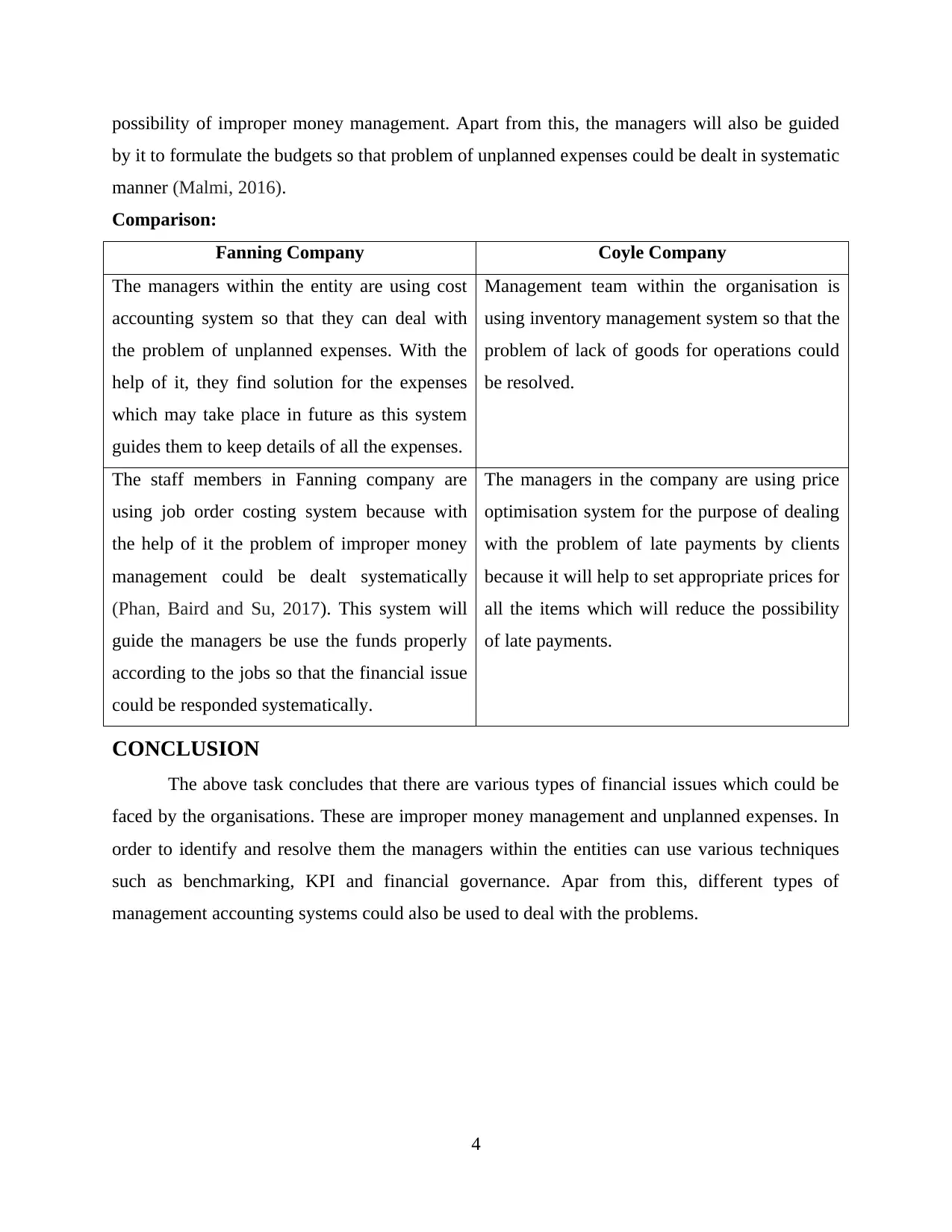
possibility of improper money management. Apart from this, the managers will also be guided
by it to formulate the budgets so that problem of unplanned expenses could be dealt in systematic
manner (Malmi, 2016).
Comparison:
Fanning Company Coyle Company
The managers within the entity are using cost
accounting system so that they can deal with
the problem of unplanned expenses. With the
help of it, they find solution for the expenses
which may take place in future as this system
guides them to keep details of all the expenses.
Management team within the organisation is
using inventory management system so that the
problem of lack of goods for operations could
be resolved.
The staff members in Fanning company are
using job order costing system because with
the help of it the problem of improper money
management could be dealt systematically
(Phan, Baird and Su, 2017). This system will
guide the managers be use the funds properly
according to the jobs so that the financial issue
could be responded systematically.
The managers in the company are using price
optimisation system for the purpose of dealing
with the problem of late payments by clients
because it will help to set appropriate prices for
all the items which will reduce the possibility
of late payments.
CONCLUSION
The above task concludes that there are various types of financial issues which could be
faced by the organisations. These are improper money management and unplanned expenses. In
order to identify and resolve them the managers within the entities can use various techniques
such as benchmarking, KPI and financial governance. Apar from this, different types of
management accounting systems could also be used to deal with the problems.
4
by it to formulate the budgets so that problem of unplanned expenses could be dealt in systematic
manner (Malmi, 2016).
Comparison:
Fanning Company Coyle Company
The managers within the entity are using cost
accounting system so that they can deal with
the problem of unplanned expenses. With the
help of it, they find solution for the expenses
which may take place in future as this system
guides them to keep details of all the expenses.
Management team within the organisation is
using inventory management system so that the
problem of lack of goods for operations could
be resolved.
The staff members in Fanning company are
using job order costing system because with
the help of it the problem of improper money
management could be dealt systematically
(Phan, Baird and Su, 2017). This system will
guide the managers be use the funds properly
according to the jobs so that the financial issue
could be responded systematically.
The managers in the company are using price
optimisation system for the purpose of dealing
with the problem of late payments by clients
because it will help to set appropriate prices for
all the items which will reduce the possibility
of late payments.
CONCLUSION
The above task concludes that there are various types of financial issues which could be
faced by the organisations. These are improper money management and unplanned expenses. In
order to identify and resolve them the managers within the entities can use various techniques
such as benchmarking, KPI and financial governance. Apar from this, different types of
management accounting systems could also be used to deal with the problems.
4
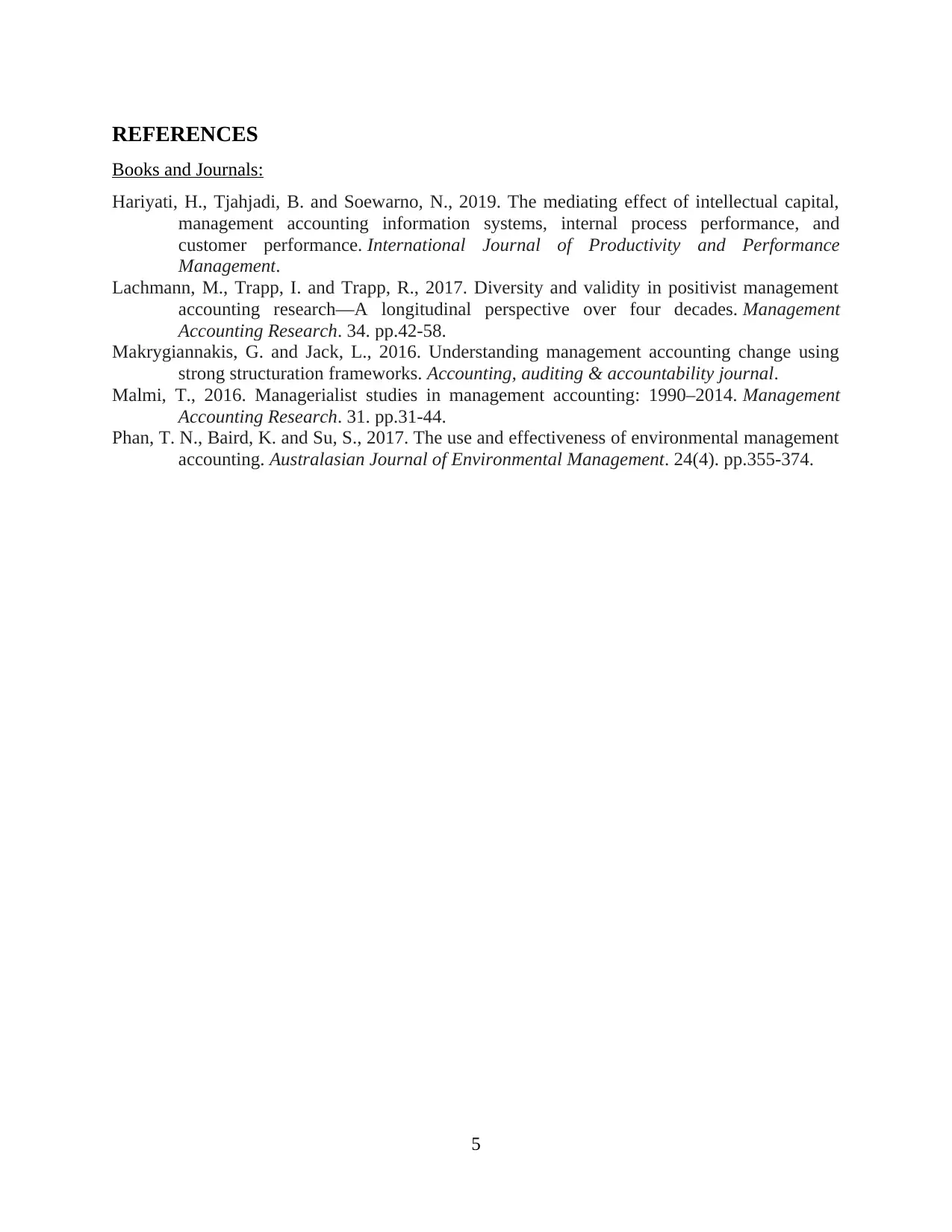
REFERENCES
Books and Journals:
Hariyati, H., Tjahjadi, B. and Soewarno, N., 2019. The mediating effect of intellectual capital,
management accounting information systems, internal process performance, and
customer performance. International Journal of Productivity and Performance
Management.
Lachmann, M., Trapp, I. and Trapp, R., 2017. Diversity and validity in positivist management
accounting research—A longitudinal perspective over four decades. Management
Accounting Research. 34. pp.42-58.
Makrygiannakis, G. and Jack, L., 2016. Understanding management accounting change using
strong structuration frameworks. Accounting, auditing & accountability journal.
Malmi, T., 2016. Managerialist studies in management accounting: 1990–2014. Management
Accounting Research. 31. pp.31-44.
Phan, T. N., Baird, K. and Su, S., 2017. The use and effectiveness of environmental management
accounting. Australasian Journal of Environmental Management. 24(4). pp.355-374.
5
Books and Journals:
Hariyati, H., Tjahjadi, B. and Soewarno, N., 2019. The mediating effect of intellectual capital,
management accounting information systems, internal process performance, and
customer performance. International Journal of Productivity and Performance
Management.
Lachmann, M., Trapp, I. and Trapp, R., 2017. Diversity and validity in positivist management
accounting research—A longitudinal perspective over four decades. Management
Accounting Research. 34. pp.42-58.
Makrygiannakis, G. and Jack, L., 2016. Understanding management accounting change using
strong structuration frameworks. Accounting, auditing & accountability journal.
Malmi, T., 2016. Managerialist studies in management accounting: 1990–2014. Management
Accounting Research. 31. pp.31-44.
Phan, T. N., Baird, K. and Su, S., 2017. The use and effectiveness of environmental management
accounting. Australasian Journal of Environmental Management. 24(4). pp.355-374.
5
1 out of 7
Your All-in-One AI-Powered Toolkit for Academic Success.
+13062052269
info@desklib.com
Available 24*7 on WhatsApp / Email
![[object Object]](/_next/static/media/star-bottom.7253800d.svg)
Unlock your academic potential
© 2024 | Zucol Services PVT LTD | All rights reserved.